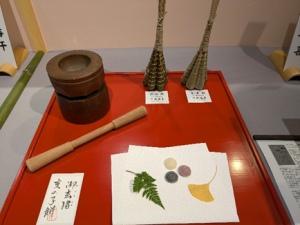Inoko mochi ~Mochi used as a talisman in the Edo period Inoko mochi by Kawabata Michiyoshi~
Yoshie Doi

Hyakumikai Exhibition on October 23, 2024 At: Gion Kaburenjo Theater Photo
OGencho-mochi, made during the Edo period
3-colored mochi, carried around as a talisman
The “Hyakumikai” exhibition, which is held once every five years, was held at the Gion Kaburenjo Theater again this year. I visited the theater on October 23rd, and met with Chizuko, the 16th wife of Douki Kawabata, for the first time in over a decade.
On April 26, 2003, at Kyo Suzume School, the 15th wife of the family head Yasuko, who was still in good health at the time, and the head priest of Joshoji Temple, Shouei Okuda, held a talk. I remember it like it was yesterday, visiting their home many times and listening to their talk until the day came.
Kawabata Douki, said to be the origin of Kyoto confectionery, was originally called Mochiya Watanabe when it was founded, but from the fourth generation onwards, it took on the name Kawabata Sei. Since calling itself Onchimaki Tsukasa Kawabata Douki, it has been a famous Japanese confectionery family that has presented gifts to the Imperial Family for nearly 400 years.
Around the time of the Onin War, the Imperial Palace was in ruins and even the Emperor’s meals were inconvenient. Out of concern, he created the original Doki mochi and presented it to the Emperor. At the time, Doki was wearing a brown-dyed kimono, so mochi came to be called “kachin” in the Imperial Court. Doki also presented mochi in an inkstone box, and so sweets were put in inkstone covers following this example, and it is said that this tradition has its roots in Doki’s style of offering.
”Inoko mochi” is sold from the end of October to early November and is used at the hearth-opening and kuchikiri tea ceremonies. Originally, the Emperor would pound small mochi with a small mortar and pestle as a gift to nobles during the Gogenji ceremony. These small mochi, the size of go stones, were colored red, white, and black and were carried around as talismans. They were thought to be especially good for sea voyages. When it reached Edo, it was swapped out for a talisman for safe childbirth, based on the boar’s fertility.
The song “Otsukutsuku” was sung along with the Emperor’s actions of pounding small rice cakes, and the song spread. It is hard to imagine rice cakes as a talisman today, but it is said that eating boar-shaped “Inoko Mochi” at Ino Hour (around 10pm) on the first day of the boar in November will ward off all illnesses. The mochi is made from newly harvested rice and is filled with soybeans, red beans, sesame seeds, chestnuts, black-eyed persimmons, sugar, etc.
It was originally a charm for good health and was first practiced at the Imperial Court during the Heian period. In the Tale of Genji, Inokomochi appears in the scene on the second night of the wedding between Hikaru Genji and Murasaki no Ue.
The end of document
Translated by Masami Otani
